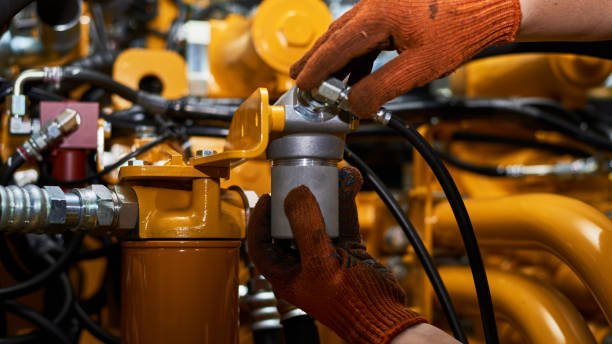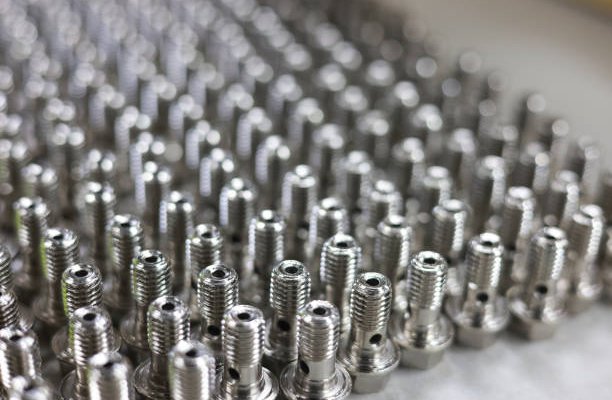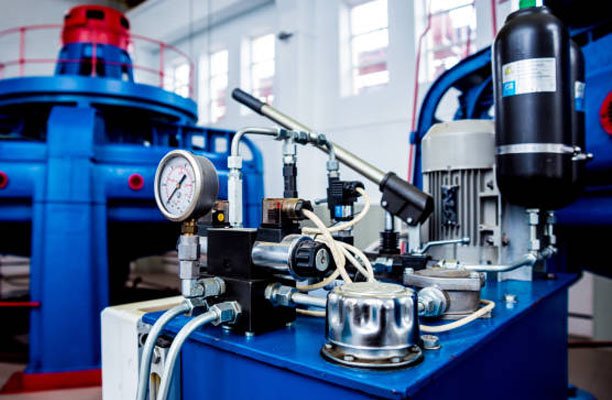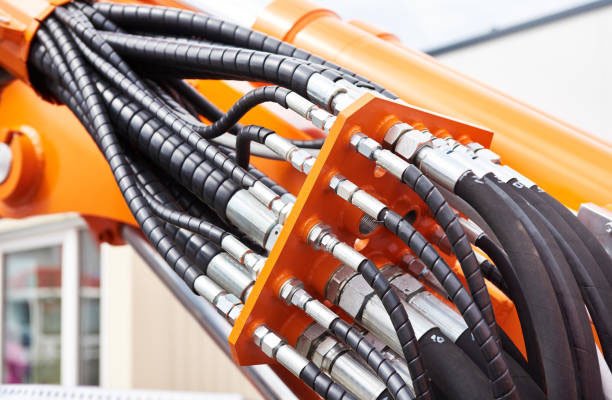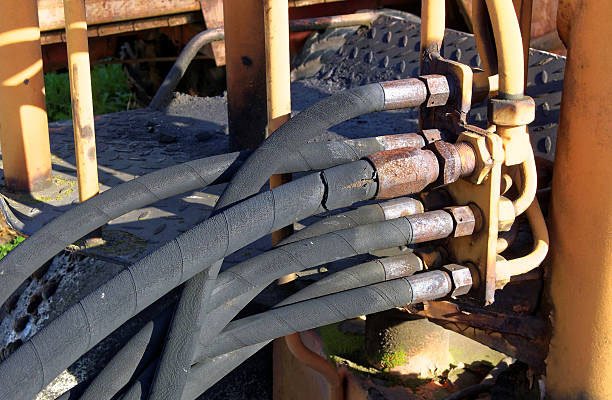Introduction
Hydraulic fittings play a crucial role in ensuring the efficiency and safety of fluid-powered systems. Whether used in industrial machinery, automotive applications, or aerospace engineering, choosing the correct fitting type can significantly impact performance and reliability.
The two main categories of hydraulic fittings are Metric and Imperial. Each follows different measurement standards and is commonly used in different regions and industries. Understanding the distinctions between these two systems is essential for compatibility, safety, and efficiency.
This article explores the differences between Metric and Imperial hydraulic fittings, their advantages, applications, and how to choose the right one for your hydraulic system.
Understanding Hydraulic Fittings
Hydraulic fittings are mechanical components used to connect pipes, hoses, and other parts in a hydraulic system. Their primary function is to ensure a secure, leak-proof connection that allows fluid to flow under high pressure.
Key factors that define hydraulic fittings include:
- Thread Type: Determines how the fitting connects (e.g., parallel or tapered threads).
- Sealing Method: Some use O-rings, while others rely on metal-to-metal contact.
- Material: Common materials include steel, stainless steel, brass, and aluminum.
- Pressure Rating: Determines how much pressure the fitting can withstand before failing.
Using the wrong fitting can lead to system failure, leaks, and potential safety hazards, making it crucial to choose the correct type for your application.
What Are Metric Hydraulic Fittings?
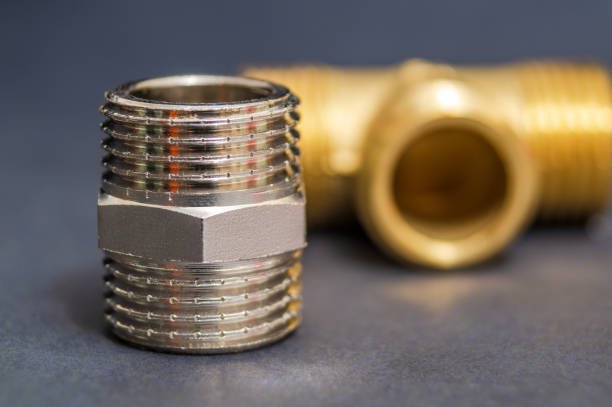
Metric hydraulic fittings are designed using the metric measurement system, which is based on millimeters. They are widely used in Europe, Asia, and other regions that follow ISO (International Organization for Standardization) and DIN (Deutsches Institut für Normung) standards.
Key Characteristics of Metric Hydraulic Fittings:
- Measured in millimeters (mm) rather than inches.
- Common thread types include Metric Parallel (M) and Metric Tapered (MT).
- Follow international standards such as ISO 6149, DIN 2353, and JIS (Japanese Industrial Standards).
- Commonly used in European-manufactured machinery, industrial equipment, and modern automotive systems.
Advantages of Metric Hydraulic Fittings:
- Standardized across many industries worldwide.
- Provides precise measurements for better fitting accuracy.
- Used in modern hydraulic systems, making them more future-proof.
Metric fittings are favored for their precision and compatibility with international equipment. However, they may not be as commonly available in regions that primarily use Imperial fittings.
What Are Imperial Hydraulic Fittings?

Imperial hydraulic fittings are measured in inches and are commonly used in North America, the UK, and industries that follow BSP (British Standard Pipe), NPT (National Pipe Thread), and SAE (Society of Automotive Engineers) standards.
Key Characteristics of Imperial Hydraulic Fittings:
- Measured in inches rather than millimeters.
- Common thread types include BSP, NPT, JIC, and SAE.
- Used extensively in industries such as oil and gas, heavy machinery, and construction.
Advantages of Imperial Hydraulic Fittings:
- Widely used in legacy systems, making replacements easier.
- Common in industries with heavy-duty applications requiring durability.
- Well-established availability in the North American market.
While Imperial fittings dominate in certain regions and industries, they can pose challenges for global compatibility, especially when working with European or Asian-manufactured machinery.
Key Differences Between Metric and Imperial Hydraulic Fittings
Although both Metric and Imperial hydraulic fittings serve the same function, they differ in several key aspects:
| Feature | Metric Hydraulic Fittings | Imperial Hydraulic Fittings |
|---|---|---|
| Measurement Units | Millimeters (mm) | Inches |
| Thread Types | Metric Parallel (M), Metric Tapered (MT) | BSP, NPT, JIC, SAE |
| Standards | ISO 6149, DIN 2353, JIS | SAE, BSP, NPT |
| Common Regions | Europe, Asia, International Markets | North America, UK |
| Industries | Automotive, Industrial Machinery | Oil & Gas, Construction, Aerospace |
Choosing the right fitting type depends on the machinery being used, regional preferences, and industry-specific requirements.
Advantages of Metric Hydraulic Fittings
Metric fittings are becoming increasingly popular due to their standardization across various industries and international markets. Some key benefits include:
- Global Standardization: Used in Europe, Asia, and many multinational industries, reducing the need for different fitting types.
- Precision & Accuracy: Metric measurements provide finer increments, making them ideal for high-precision applications.
- Modern Equipment Compatibility: Most new hydraulic systems, especially those manufactured in Europe and Asia, are designed for metric fittings.
Despite these advantages, metric fittings may not always be compatible with legacy machinery in North America or industries that primarily use Imperial systems.
Advantages of Imperial Hydraulic Fittings
Imperial hydraulic fittings have been a standard in North America, the UK, and industries that rely on heavy-duty machinery. Their legacy and widespread use make them essential in various applications.
- Established in Heavy Industries: Used in oil & gas, mining, and construction, where equipment longevity and compatibility are crucial.
- Interchangeability: Many older machines and industrial setups rely on Imperial fittings, making replacements and repairs easier.
- Stronger Tapered Threads: Some Imperial fittings, such as NPT, use tapered threads that create a tight seal without additional sealing components.
Although Imperial fittings remain dominant in certain sectors, the global shift towards metric standardization may eventually limit their usage outside of North America.
Common Applications of Metric Hydraulic Fittings
Metric hydraulic fittings are commonly found in industries and machinery that require precision and follow international standards. These include:
- Automotive Industry: Many European and Asian car manufacturers use metric fittings for their hydraulic brake and fuel systems.
- Heavy Machinery: Equipment like excavators, cranes, and agricultural machinery in international markets are often designed with metric hydraulic systems.
- Industrial Equipment: Factories and manufacturing plants with automated hydraulic systems prefer metric fittings due to their standardization.
- Aerospace Applications: Many aircraft manufacturers outside North America rely on metric standards for hydraulic components.
With global standardization efforts, metric fittings are gaining widespread adoption across industries that require high precision and international compatibility.
Common Applications of Imperial Hydraulic Fittings
Imperial fittings continue to dominate industries where legacy systems and heavy-duty applications are prevalent. These include:
- Oil & Gas Industry: Many drilling rigs, refineries, and pipelines in North America use Imperial hydraulic fittings.
- Construction & Mining Equipment: Hydraulic systems in bulldozers, loaders, and dump trucks commonly feature Imperial fittings.
- Aerospace Industry: Many aircraft manufacturers in North America still use Imperial measurements for their hydraulic systems.
- Military & Defense: Defense-related vehicles and equipment in the U.S. often rely on Imperial fittings for consistency in manufacturing.
Imperial fittings remain essential in North American industries, but companies operating internationally may face compatibility challenges when integrating with metric systems.
How to Choose the Right Hydraulic Fitting?
Selecting the correct hydraulic fitting is essential for system efficiency, safety, and longevity. Here are some key factors to consider:
- Pressure Rating: Ensure the fitting can withstand the system’s pressure requirements to prevent leaks and failures.
- Material Compatibility: Choose fittings made from materials resistant to corrosion, such as stainless steel or brass, depending on the fluid type.
- Thread Type: Confirm whether the system uses metric (M, MT) or Imperial (BSP, NPT, JIC) threads to avoid mismatched connections.
- Sealing Method: Determine if the fitting relies on O-rings, metal-to-metal sealing, or tapered threads.
- Application-Specific Needs: Some industries, such as aerospace, require specific certifications and standards compliance.
By carefully evaluating these factors, you can ensure a reliable and efficient hydraulic system with minimal risk of leaks or failures.
Interchangeability: Can You Mix Metric and Imperial Fittings?
Mixing metric and Imperial hydraulic fittings is not recommended due to significant differences in thread design, sealing mechanisms, and measurement standards. However, in some cases, conversion adapters can be used.
Potential Issues with Mixing Fittings:
- Cross-Threading: Since metric and Imperial threads have different pitches and angles, forcing an incorrect connection can damage components.
- Leaks & Pressure Loss: Mismatched fittings may not form a proper seal, leading to hydraulic fluid leaks.
- Safety Risks: In high-pressure systems, improper fittings can fail catastrophically, causing operational hazards.
Solutions:
- Use hydraulic conversion adapters to safely connect metric and Imperial fittings.
- Replace outdated fittings with the correct type to maintain system integrity.
- Consult manufacturer guidelines before attempting to mix fittings.
To ensure optimal performance and safety, it’s best to use fittings that match the original system specifications.
Hydraulic Fitting Standards & Certifications
Different industries require hydraulic fittings to comply with specific standards to ensure performance, safety, and compatibility. Below are some of the most common certification organizations and standards:
- ISO (International Organization for Standardization): ISO 6149 regulates metric hydraulic fittings and sealing methods.
- DIN (Deutsches Institut für Normung): DIN 2353 specifies tube fittings for hydraulic applications.
- SAE (Society of Automotive Engineers): SAE J514 and J1453 define standards for hydraulic fittings in North America.
- BSP (British Standard Pipe): Commonly used in the UK and includes BSPP (parallel) and BSPT (tapered) fittings.
- NPT (National Pipe Thread): Tapered thread system used primarily in North America.
- JIS (Japanese Industrial Standards): Hydraulic fittings used in Japanese-manufactured machinery.
Choosing fittings that comply with these standards ensures compatibility, reliability, and compliance with industry regulations.
Maintaining and Troubleshooting Hydraulic Fittings
Proper maintenance of hydraulic fittings is crucial for ensuring long-term performance and preventing costly system failures. Here are some best practices for maintaining and troubleshooting hydraulic fittings:
Preventative Maintenance Tips:
- Regular Inspections: Check for signs of wear, corrosion, and leaks in hydraulic fittings.
- Use the Right Tools: Avoid overtightening, which can damage threads and sealing surfaces.
- Monitor Fluid Levels: Low fluid levels or contamination can cause excessive pressure and fitting failures.
- Replace Damaged Components: If a fitting shows signs of cracks or leaks, replace it immediately to prevent further damage.
Common Issues and Solutions:
| Issue | Possible Cause | Solution |
|---|---|---|
| Leakage | Loose fittings, damaged O-rings, worn-out seals | Tighten fittings properly, replace seals |
| Cross-threading | Mismatched threads (Metric vs. Imperial), overtightening | Use correct fitting type, align threads carefully |
| Corrosion | Exposure to moisture, harsh chemicals | Use stainless steel or corrosion-resistant materials |
Regular maintenance helps extend the life of hydraulic fittings and ensures the safety of the entire hydraulic system.
Future Trends in Hydraulic Fittings
With advancements in hydraulic technology, new trends are emerging in the industry. Here are some future developments in hydraulic fittings:
- Standardization Towards Metric Systems: Many industries are shifting towards metric fittings to improve global compatibility.
- Smart Hydraulic Fittings: Sensors integrated into fittings can monitor pressure, temperature, and fluid flow in real time.
- Eco-Friendly Materials: The industry is exploring recyclable and biodegradable materials to reduce environmental impact.
- Enhanced Leak Prevention Designs: New sealing technologies, such as metal-to-metal sealing, are being developed for improved durability.
These innovations will continue to improve the efficiency and sustainability of hydraulic systems in various industries.
Conclusion
Understanding the differences between Metric and Imperial hydraulic fittings is essential for selecting the right components for your system. While metric fittings offer precision and global standardization, Imperial fittings remain dominant in North American industries.
Key Takeaways:
- Metric fittings are used globally and follow ISO, DIN, and JIS standards.
- Imperial fittings are more common in North America and follow BSP, NPT, and SAE standards.
- Mixing metric and Imperial fittings is not recommended due to compatibility issues.
- Choosing the right fitting depends on application, pressure rating, and industry requirements.
By understanding these key differences and best practices, you can ensure a reliable and efficient hydraulic system for your specific needs.
FAQs
1. Which is better: metric or imperial hydraulic fittings?
Neither system is universally better; the choice depends on the industry, region, and application. Metric fittings are preferred for international compatibility and precision, while Imperial fittings are more common in North America and industries with legacy systems.
2. Are metric and BSP fittings the same?
No, metric and BSP (British Standard Pipe) fittings are different. BSP fittings use thread sizes measured in inches and are commonly used in the UK and Australia, while metric fittings are measured in millimeters and follow ISO or DIN standards.
3. How do I identify hydraulic fitting thread types?
To identify a hydraulic fitting thread type:
- Measure the thread diameter using a caliper.
- Determine the pitch using a thread gauge.
- Check whether the thread is parallel (straight) or tapered.
- Compare with standard thread charts to match the fitting type.
4. Can I convert metric fittings to imperial?
Yes, conversion adapters are available to connect metric and Imperial hydraulic fittings. However, it’s best to use the correct fitting type for the system to prevent leaks, pressure loss, and potential safety risks.
5. What industries still use imperial hydraulic fittings?
Imperial hydraulic fittings are still widely used in industries such as:
- Oil & Gas
- Construction & Heavy Equipment
- Aerospace (mainly in North America)
- Military & Defense
However, many companies are gradually transitioning to metric fittings due to global standardization.

